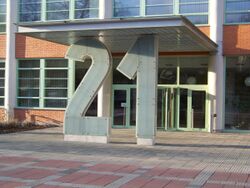21 (number)
| ||||
|---|---|---|---|---|
| Cardinal | twenty-one | |||
| Ordinal | 21st (twenty-first) | |||
| Factorization | 3 × 7 | |||
| Divisors | 1, 3, 7, 21 | |||
| Greek numeral | ΚΑ´ | |||
| Roman numeral | XXI | |||
| Binary | 101012 | |||
| Ternary | 2103 | |||
| Quaternary | 1114 | |||
| Quinary | 415 | |||
| Senary | 336 | |||
| Octal | 258 | |||
| Duodecimal | 1912 | |||
| Hexadecimal | 1516 | |||
| Vigesimal | 1120 | |||
| Base 36 | L36 | |||
21 (twenty-one) is the natural number following 20 and preceding 22.
The current century is the 21st century AD, under the Gregorian calendar.
In mathematics
Twenty-one is the fifth distinct semiprime,[1] and the second of the form [math]\displaystyle{ 3 \times q }[/math] where [math]\displaystyle{ q }[/math] is a higher prime.[2]
As a biprime with proper divisors 1, 3 and 7, twenty-one has a prime aliquot sum of 11 within an aliquot sequence containing only one composite number (21, 11, 1, 0); it is the second composite member of the 11-aliquot tree, following 18. 21 is the first member of the second cluster of two discrete semiprimes (21, 22), where the next such cluster is (38, 39). 21 is the smallest natural number that is not close to a power of two [math]\displaystyle{ (2^n) }[/math], where the range of nearness is [math]\displaystyle{ \pm {n} }[/math]. 21 is a Harshad number in base ten,[3] and a repdigit in quaternary (1114).
While 21 is the sixth triangular number,[4] it is also the sum of the divisors of the first five positive integers:
[math]\displaystyle{ \begin{align} 1 & + 2 + 3 + 4 + 5 + 6 = 21 \\ 1 & + (1 + 2) + (1 + 3) + (1 + 2 + 4) + (1 + 5) = 21 \\ \end{align} }[/math]
21 is the fifth Motzkin number,[5] and the eighth Fibonacci number, equal to the sum of the preceding terms in the sequence, 8 and 13. It is the smallest non-trivial example in decimal of a Fibonacci number whose digits are Fibonacci numbers and whose digit sum is also a Fibonacci number.[6] It is also an octagonal number,[7] and a Padovan number (preceded by the terms (9, 12, 16), where it is the sum of the first two of these).[8] 21 is a Blum integer, since it is a semiprime with both its prime factors being Gaussian primes.[9]
While the twenty-first prime number 73 is the largest member of Bhargava's definite quadratic 17–integer matrix [math]\displaystyle{ \Phi_{s}(P) }[/math] representative of all prime numbers,[10] [math]\displaystyle{ \Phi_{s}(P) = \{2, 3, 5, 7, 11, 13, 17, 19, 23, 29, 31, 37, 41, 43, 47, 67, \bold {73} \}, }[/math]
the twenty-first composite number 33 is the largest member of a like definite quadratic 9–integer matrix[11] [math]\displaystyle{ \Phi_{s}(2\mathbb {Z} _{\ge 0} + 1) = \{1, 3, 5, 7, 11, 15, \bold {33} \} }[/math]
representative of all odd numbers.[12][lower-alpha 1]
21 is also the largest positive integer [math]\displaystyle{ n }[/math] that has the following property (see brief proof below):
For any positive integers [math]\displaystyle{ a,b }[/math] such that [math]\displaystyle{ a + b = n }[/math], at least one of [math]\displaystyle{ \tfrac{a}{b} }[/math] and [math]\displaystyle{ \tfrac{b}{a} }[/math] is a terminating decimal.
|
|---|
|
Note that a necessary condition for [math]\displaystyle{ n }[/math] is that for any [math]\displaystyle{ a }[/math] coprime to [math]\displaystyle{ n }[/math] and [math]\displaystyle{ n - a }[/math] must satisfy the condition above, therefore at least one of [math]\displaystyle{ a }[/math] and [math]\displaystyle{ n - a }[/math] must only have factor 2 and 5. Let [math]\displaystyle{ A(n) }[/math] denote the quantity of the numbers smaller than [math]\displaystyle{ n }[/math] that only have factor 2 and 5 and that are coprime to [math]\displaystyle{ n }[/math], we instantly have [math]\displaystyle{ \frac{\varphi(n)}{2} \lt A(n) }[/math]. We can easily see that for sufficiently large [math]\displaystyle{ n }[/math], [math]\displaystyle{ A(n) \sim \frac{\log_2(n) \log_5(n)}{2} = \frac{\ln^{2}(n)}{2 \ln(2) \ln(5)} }[/math], but [math]\displaystyle{ \varphi(n) \sim \frac {n} {e^\gamma\; \ln \ln n} }[/math], [math]\displaystyle{ A(n) = o(\varphi(n)) }[/math] as [math]\displaystyle{ n }[/math] goes to infinity, thus [math]\displaystyle{ \frac{\varphi(n)}{2} \lt A(n) }[/math] fails to hold for sufficiently large [math]\displaystyle{ n }[/math]. In fact, for every [math]\displaystyle{ n \gt 2 }[/math], we have
and
so [math]\displaystyle{ \frac{\varphi(n)}{2} \lt A(n) }[/math] fails to hold when [math]\displaystyle{ n \gt 273 }[/math] (actually, when [math]\displaystyle{ n \gt 33 }[/math]). Just check a few numbers to see that the complete sequence of numbers having this property is: 2, 3, 4, 5, 6, 7, 8, 9, 11, 12, 15, 21. |
Twenty-one is the smallest number of differently sized squares needed to square the square.[13]
21 is the number of prime numbers have two digits.[14]
In science
- The atomic number of scandium.
- It is very often the day of the solstices in both June and December, though the precise date varies by year.
Age 21
- In thirteen countries, 21 is the age of majority. See also: Coming of age.
- In eight countries, 21 is the minimum age to purchase tobacco products.
- In seventeen countries, 21 is the drinking age.
- In nine countries, it is the voting age.
- In the United States:
- 21 is the minimum age at which a person may gamble or enter casinos in most states (since alcohol is usually provided).
- 21 is the minimum age to purchase a handgun or handgun ammunition under federal law.
- 21 is the age at which one can purchase multiple tickets to an R-rated film.
- In some states, 21 is the minimum age to accompany a learner driver, provided that the person supervising the learner has held a full driver license for a specified amount of time. See also: List of minimum driving ages.
In sports
- Twenty-one is a variation of street basketball, in which each player, of which there can be any number, plays for himself only (i.e. not part of a team); the name comes from the requisite number of baskets.
- In three-on-three basketball games held under FIBA rules, branded as 3x3, the game ends by rule once either team has reached 21 points.
- In badminton, and table tennis (before 2001), 21 points are required to win a game.
- In AFL Women's, the top-level league of women's Australian rules football, each team is allowed a squad of 21 players (16 on the field and five interchanges).
- In NASCAR, 21 has been used by Wood Brothers Racing and Ford for decades. The team has won 99 NASCAR Cup Series races, a majority with 21, and 5 Daytona 500's. Their current driver is Harrison Burton.
In other fields
21 is:
- The Twenty-first Amendment repealed the Eighteenth Amendment, thereby ending Prohibition.
- The number of spots on a standard cubical (six-sided) die (1+2+3+4+5+6)
- The number of firings in a 21-gun salute honoring royalty or leaders of countries
- "Twenty One", a 1994 song by an Irish rock band The Cranberries
- "21 Guns", a 2009 song by the punk-rock band Green Day
- Twenty One Pilots, an American musical duo
- There are 21 trump cards of the tarot deck if one does not consider The Fool to be a proper trump card.
- The standard TCP/IP port number for FTP connection
- The Twenty-One Demands were a set of demands which were sent to the China government by the Japanese government of Okuma Shigenobu in 1915
- 21 Demands of MKS led to the foundation of Solidarity in Poland.
- In Israel, the number is associated with the profile 21 (the military profile designation granting an exemption from the military service)
- Duncan MacDougall reported that 21 grams (0.74 oz) is the weight of the soul, according to an experiment.
- The number of the French department Côte-d'Or
- Twenty-One, an ancient card game in which the key value and highest-winning point total is 21
- Blackjack, a modern version of Twenty-One played in casinos
- The number of shillings in a guinea
- The number of solar rays in the flag of Kurdistan
- Twenty-One, an American game show that became the center of the 1950s quiz show scandals when it was shown to be rigged
- The number on the logo for the American game show Catch 21
- Twenty-One, a 1991 British-American drama film directed by Don Boyd and starring Patsy Kensit
- Cinema XXI (21), A Cinema franchise in Indonesia
References
- ↑ On the other hand, the largest member of an integer quadratic matrix representative of all numbers is 15,[math]\displaystyle{ \Phi_{s}(\mathbb {Z} _{\ge 0}) = \{1, 2, 3, 5, 6, 7, 10, 14, \bold {15} \} }[/math] where the aliquot sum of 33 is 15, the second such number to have this sum after 16 (A001065); see also, 15 and 290 theorems.
- ↑ Sloane, N. J. A., ed. "Sequence A001358". OEIS Foundation. https://oeis.org/A001358.
- ↑ Sloane, N. J. A., ed. "Sequence A001748". OEIS Foundation. https://oeis.org/A001748.
- ↑ "Sloane's A005349 : Niven (or Harshad) numbers". OEIS Foundation. https://oeis.org/A005349.
- ↑ "Sloane's A000217 : Triangular numbers". OEIS Foundation. https://oeis.org/A000217.
- ↑ "Sloane's A001006 : Motzkin numbers". OEIS Foundation. https://oeis.org/A001006.
- ↑ "Sloane's A000045 : Fibonacci numbers". OEIS Foundation. https://oeis.org/A000045.
- ↑ "Sloane's A000567 : Octagonal numbers". OEIS Foundation. https://oeis.org/A000567.
- ↑ "Sloane's A000931 : Padovan sequence". OEIS Foundation. https://oeis.org/A000931.
- ↑ "Sloane's A016105 : Blum integers". OEIS Foundation. https://oeis.org/A016105.
- ↑ Sloane, N. J. A., ed. "Sequence A154363 (Numbers from Bhargava's prime-universality criterion theorem)". OEIS Foundation. https://oeis.org/A154363. Retrieved 2023-10-13.
- ↑ Sloane, N. J. A., ed. "Sequence A116582 (Numbers from Bhargava's 33 theorem.)". OEIS Foundation. https://oeis.org/A116582. Retrieved 2023-10-09.
- ↑ Cohen, Henri (2007). "Consequences of the Hasse–Minkowski Theorem". Number Theory Volume I: Tools and Diophantine Equations. Graduate Texts in Mathematics. 239 (1st ed.). Springer. pp. 312–314. ISBN 978-0-387-49922-2. OCLC 493636622. https://link.springer.com/book/10.1007/978-0-387-49923-9.
- ↑ C. J. Bouwkamp, and A. J. W. Duijvestijn, "Catalogue of Simple Perfect Squared Squares of Orders 21 Through 25." Eindhoven University of Technology, Nov. 1992.
- ↑ Sloane, N. J. A., ed. "Sequence A006879 (Number of primes with n digits.)". OEIS Foundation. https://oeis.org/A006879.
 |



